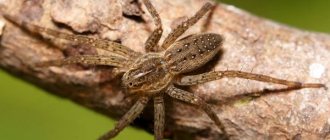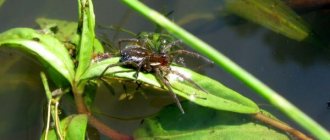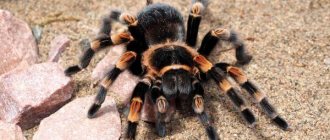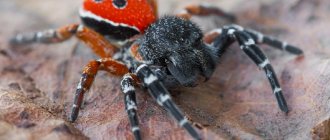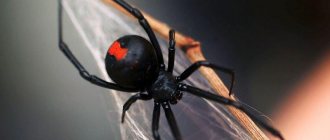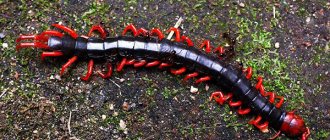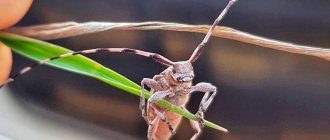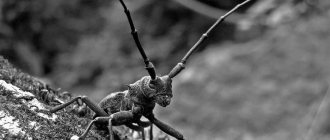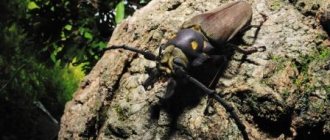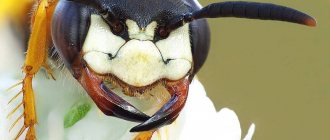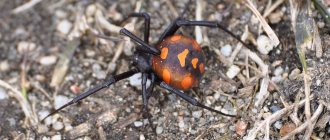Solpuga or phalanx (Solifugae) is an order of arachnids, often called “bihors”, “wind scorpions” and “camel spiders”. The order includes 13 families, 140 genera and about 1000 species, all of which live in arid areas. It is important to note that, contrary to popular belief, salpugs are not spiders or scorpions.
Solpuga or phalanx (Solifugae), appearance
Under different names
Author of the photo:
Translated from Latin, the name of the order Solifugae means “running away from the sun.” Two more names are common in the world - phalanges and bihorci.
In the dry regions of Southern Africa they are called "barbers" or "barbers". This is because local tribes have the opinion that arthropods cut off human hair, as well as animal fur, in order to equip their nests with them.
In Asia they are called camel spiders, but in Europe you can hear the names “windy scorpion” or “sun spider”. Residents of Uzbekistan and Turkmenistan call them alli gusola, which means bull's head.
2
What is the distribution area
The phalanx prefers climate zones:
- tropical;
- subtropical;
- moderate.
Selects desert and semi-desert areas. The insect waits out the heat of the day in shelters. Will live in abandoned rodent burrows or self-dug dwellings. The representative has been using the selected home for an extended period of time.
They live in tropical forests
Body structure
The phalanges are quite large arthropods. For example, adult Central Asian salpugs grow up to 7 cm in length. Other species average from 4 to 5 cm.
Their entire body is covered with small hairs, and their color depends on their habitat. Basically, it is sandy-yellow, brown and even whitish in color. The body is divided into three parts. The head is quite large and convex. The chest is segmented, dividing into three equal parts. But the oblong abdomen has 9–10 segments. They all look pretty scary.
In front are the pedipalps, which resemble limbs. At the end there are powerful claws covered with a powerful shield. Among arachnids, salpugs have the most powerful chelicerae, capable of biting prey in half. Three pairs of limbs are attached to the head section, and the rest to the thoracic segments. The hind limbs of salpugs are much longer than the rest.
Don’t miss the fascinating material on our website most-beauty.ru about the TOP 20 most beautiful spiders in the world.
3
What a lifestyle
As the arachnid matures, it molts. In winter, the representative hibernates to wait out the temperature unsatisfactory for living. Some of the subspecies also do this in the summer, when it becomes excessively hot outside.
In the wild, salpuga dies only after 3-4 years. The insect is characterized by fast movement speed and high maneuverability. The phalanx is capable of moving along a vertical surface.
Large representatives are capable of jumping to a meter height.
Habits and lifestyle
Unlike other arachnids, they are mobile creatures. Fast predators, capable of speeds of up to 2 km per hour, hunt at night. But there are also daytime hunters. Their victims include ants, termites, species of beetles, and related arthropods. Powerful tentacles allow you to cope with lizards.
They can track their prey by chasing it and then suddenly attacking from behind. We learned to hunt from ambush. They easily gnaw through beehives and termite mounds. They track the prey with their senses of touch, their eyes, and also feel the vibration of the soil.
The lifestyle and behavior of the phalanges combine the features of primitive creatures with signs of high organization. Sensing danger, they throw the back of their body over their head and begin to squeak loudly. This frightening sound is created by the friction of the chelicerae against each other. They jump and spin in place at the same time. To hide from enemies, salpugs dig deep holes and cover the entrances with foliage.
4
Consequences of a bite and treatment measures
Despite the high pain of the bite site, these arachnids do not have poisonous glands.
Most often, collisions with them pass without any consequences. In rare cases, severe inflammation occurs. This is due to the presence of rotting remains of the previous victim on the chelicerae. When bitten, these residues enter the wound and cause various arachnoses.
You can relieve pain yourself using analgesics, or you can go to a medical facility.
In any case, the wound needs to be treated with a disinfectant.
Next, you need to apply a bandage with a gel or ointment that contains an antibiotic. Dressing should be done daily until complete healing.
Bites
The appearance of salpugs is truly menacing. There is a myth that they are poisonous and can cause human death. But that's not true. The bite is really painful, but does not pose a danger to humans. They have neither poisonous glands nor deadly poison. Some species easily bite through human skin.
The only thing that needs to be done after a bite is to treat the wound to prevent infection. The chelicerae store rotting food debris, which can cause inflammation. And so, this is a completely harmless creature.
By the way, on our website most-beauty.ru you can find a list of the most poisonous spiders on our planet.
5
Is salpuga dangerous for humans and pets?
There are many myths and beliefs associated with this arachnid. Despite this, the danger of the phalanx to people is minimal, since it is not poisonous. Thanks to its powerful chelicerae, salpuga is able to bite through a human nail, but the bite does not pose a serious threat. The arachnid can only harm small pets, such as decorative mice and hamsters.
It should be noted that the salpuga is not afraid of people and is highly aggressive. In addition, representatives of this order are attracted to light. It is very difficult to catch an arachnid that ends up in a house due to its speed of movement.
Possible consequences of a bite and how to avoid them
The only thing that really poses a threat is rotten food debris, which, when bitten, can get into the wound. To avoid the development of inflammatory processes and blood poisoning, it is necessary to treat the damaged area of skin with hydrogen peroxide; you can also wash it with soap and water. It is strictly not recommended to use iodine and brilliant green, as they will significantly slow down the healing of the wound. If inflammation does begin, you should consult a doctor to prescribe antibiotics.
Please note that the salpuga is aggressive and very fast, so you should not try to catch it, much less touch it. By the way, killing her is also not so easy; in particular, it is impossible to crush her on the sand.
In addition, the salpug is attracted to bright light, so if you spend the night in a tent and turn on a flashlight, you should definitely close it, otherwise the phalanx spider may come running to it.
Salpugs are an unusual and interesting order of arachnids, with many species. Unfortunately, it has been poorly studied, because in the natural environment it is difficult to observe salpugs due to their high speed of movement, and in laboratory conditions they do not live long.
Reproduction
The mating season for different types of phalanges depends on the area of settlement. Mating usually occurs at night. The female attracts males with a special smell.
The male secretes spermatophores and, with the help of chelicerae, transfers them to the genital opening of the female. This entire process takes from 2 to 4 minutes.
After mating, the male quickly runs away so that the female does not satisfy her hunger with him. In the female’s body, the development and formation of fertilized appendages occurs. During this period, she eats a lot, and after a while she lays eggs in a pre-prepared hole in the soil.
Photos and names of species
Now let’s talk in more detail about the species of salpugs that live in different parts of the world.
Phalanx spider care
The phalanx spider has many different species. Different types of salpug (phalanx) have different care needs. Camel spiders should be provided with an appropriate substrate similar to their natural habitat, be it soil, sand, mulch or peat moss.
Some species are burrowers, so their substrate must be deep enough for them to dig. All species require plenty of cover and plenty of options for hiding. They can be fed a variety of small insects.
Common / Galeodes araneoides
This species, common in Russia and Central Asian countries, is also called the South Russian salpuga. In addition to the south of Russia, they are found in the steppes of Ukraine and Kazakhstan. The settlement area stretches from Egypt to Afghanistan.
Adult males reach 6 cm. Females are smaller - no more than 4.5 cm. This species has a sandy-yellow body color, and small dark spots can be seen on the back.
Zoologists believe that the type locality is located within the modern Volgograd region. This species was first described by Russian zoologist Peter Pallas. In 1772, he included the inhabitants of the southern steppes, deserts and semi-deserts in the scientific classification.
Arabian salpuga / Galeodes arabicus
The distribution area of the formidable-looking phalanx is limited to the countries of North Africa and the Arabian Peninsula. The “Arabian” predator feeds on small insects and other arthropods.
They grow up to 5 cm. The entire body and limbs are covered with long hairs. They lead a nocturnal lifestyle, and during the day they hide from the sun and enemies under stones, in burrows, and crevices.
They are not poisonous, and therefore often end up in home terrariums. At home they are quite voracious, but it is better not to overfeed.
Description of the insect
Salpugs are a very peculiar order. Their structure and way of life are a combination of primitivism and signs of high development.
Appearance
Basically, salpugs have quite impressive shapes. Their dimensions are 5–7 cm. A very small part of the species has a body length of no more than 1–1.5 cm. The prevailing color is brown-yellow, sandy-yellow and whitish tones. It is much less common to find a mottled or dark species. Salpuga has a dismembered cephalothorax. On the anterior section, protected by a large head shield, there are pedipalps, chelicerae and forelegs. Large chelicerae have swollen main segments and powerful, forward-directed claws. They are able to open vertically, and there are strong teeth on the inner edges of the fingers. The structure of the pedipalps is similar to the legs, but lacks claws. They are replaced by a tactile appendage. The pedipalps not only perform motor and tactile functions, but also, with the help of strong bristles, grasp and hold prey. Pedipalps are also used by males during copulation.
The dissected segments of the second, third and fourth pairs of legs have individual tergites. The legs are different in structure. The front ones are short and thin, perform the function of touch. The remaining legs are equipped with claws and are organs of movement. The longest legs are the hind legs. They have from two to five pairs of peculiar triangular, lamellar organs - maleoli. They are distinguished by numerous sensilla and sensory cells, which are combined into a nerve through processes. A characteristic feature of the head shield is a clearly visible ocular tubercle with two convex eyes. A distinctive feature is the underdevelopment of the lateral eyes. On the lower surface of the cephalothorax, the triangular coxae of the pedipalps and walking legs are clearly visible.
The abdomen, consisting of ten dissected segments, is large and fusiform in shape. With the help of the pregenital segment, the abdomen has articulation with the cephalothorax. A characteristic feature is a very powerful and well-developed tracheal system. Salpugs have a body and appendages covered with hairs and bristles. One part of the hairs and bristles is very soft, the other part is thickened or spiny. There are hairs and bristles that stick out singly or are very long.
Reproduction
The genital opening in salpugs is a longitudinal slit on the first segment of the abdomen. It is covered with side flaps. Most often, the mating period occurs in the dark. The male identifies and finds the female by smell. At the moment of mating, the female becomes absolutely motionless, and the male is active. Fertilization is spermatophore. The entire mating process takes a few minutes: the male releases a sticky spermatophore containing spermine.
Then from the surface of the soil it is transferred with the help of chelicerae to the genital opening of the female. The fertilized female gains mobility, aggression and gluttony. Immediately after feeding, the female digs out a small depression that widens at the bottom.
The entire process of embryonic development occurs directly in the oviducts.
The eggs laid in the burrow hatch into babies within a very short period of time. They cannot move and have a special covering of transparent cuticle. After two weeks, the first molt occurs and the young salbuga becomes covered with hairs and acquires motor activity. The female protects the young and feeds them for quite a long time. The life expectancy and total number of moults in salpugs still remains a mystery.
Nutrition
The extremely voracious salpugs feed on a variety of animals. The main condition is the ability to cope with your victim. The main food sources used are insects, millipedes, spiders, wood lice and termites. Large individuals can attack small lizards, as well as chicks of small birds and young rodents.
The caught prey is grabbed with lightning speed and held tightly. Then the salpuga tears it apart, kneads it with the help of chelicerae, moistens it abundantly with digestive juice and sucks it up. Having eaten, the salpuga significantly increases in size in the abdominal area and completely loses the ability to catch prey.
Habitat
Solpugi inhabited the southern coast of the Crimean peninsula, the Lower Volga region, including the Volgograd and Astrakhan regions, as well as Kalmykia. Habitat is the North Caucasus and Transcaucasia, the republics of Central Asia: Kazakhstan, Kyrgyzstan, Tajikistan. They are common in Spain and Greece. Salpugs are absent only in Australia and Antarctica.
The activity of these animals increases in the dark. In daylight, salpugs take refuge under stones, in burrows of rodents or other animals. Sometimes they independently dig holes with chelicerae, and throw away excess soil with their feet. The same hole can be used for quite a long time.
Nocturnal salpugs are attracted to a variety of light sources. The places where they accumulate are illuminated rooms, residential buildings and places around street lamps. Most of all, salpugs love the radiation from ultraviolet lamps. However, there are species that enjoy sunlight. These include Spanish sun spiders and Central Asian paragaleodes heliophilus.
Smoky / Galeodes fumigatus
The inhabitant of the desert regions of Turkmenistan has a dark brown color. There are also completely black individuals. This type, of course, can scare.
They grow up to 7 cm in length, and therefore are considered one of the largest representatives of the Galeodes genus. They track their victims at night and hide in holes during the day. Some individuals use the same hole, but most find a new shelter every day.
They move quickly using walking legs. To this ability we add that they can easily overcome obstacles with a vertical surface.
Lifestyle and behavior in nature
An arid, hot climate suits these animals; only rare species of these arachnids live in forest areas. The greatest activity occurs in the dark, while during the day the phalanxes prefer to hide in shelters. It is impossible not to note the habit of salpugs to change their home every night; only certain representatives of this detachment “remain faithful” to their “home”.
Salpuga on rocky ground.
To see this animal, you don’t have to make any special efforts; you just need to turn on the light or make a fire in the evening - these little eight-legged creatures are already right there!
Thanks to their ability to move quickly (up to 16 km/h) and jump high, salpugs received the nickname “wind scorpion”.
Transcaspian salpuga / Galeodes caspius
This species is also known under the name Camel spider. This name has been assigned to the inhabitants of the steppes of Kazakhstan and Kyrgyzstan, but in fact it is not a spider at all. It looks very menacing, but is not dangerous to humans, as it is not poisonous.
It may hurt to bite. The species is quite aggressive. It can even attack dangerous scorpions. The giant salpuga, growing up to 7 cm, easily copes with the poisonous creature.
The color of the head and chest is brown with a slightly reddish tint. But their abdomen is grayish with dark transverse stripes.
Nutrition
Extremely voracious fertilized females. If he manages to defeat the rodent, he eats everything in one go. With its powerful jaws it tears apart the shell and gnaws out the insides. The murder weapon is claws, tentacles, and powerful jaws. The spider does not inject venom and does not paralyze the victim.
The main diet is insects, beetles, spiders. Larger species attack chicks, rodents, lizards, frogs, toads, and scorpions. Salpugs have practically no natural enemies. The power of the chelicerae allows you to easily cut off feathers, fur, cut through skin, shell, and crush thin bones.
On a note!
When attacked, the phalanx emit an unpleasant piercing squeak and chirping sound.
Camel spider (salpuga, phalanx spider)
Crimean salpuga
Among the diversity of the world of spiders of Crimea, in the foothill arid regions of the southern part of the peninsula, you can meet beautiful phalanges. Unlike tarantulas and karakurts, they are non-poisonous.
They reach a length of 5 to 6 cm. The color is light. They are active in the dark, hunting insects, small lizards, and scorpions.
This species has a complex structure of visual organs, providing them with a good reaction. They not only see the victim, but also feel its approach through the vibration of the soil. It is noteworthy that they are practically not afraid of humans and can easily join a night rest around a tourist fire.
What do phalanges eat?
These are real predators! Moreover, they are very, very gluttonous. Now you will find out why at the beginning of the story they were called gluttons. When the salpuga catches its prey, it eats it without stopping, even if the prey is larger than it is in size.
There were cases when this animal ate until its abdomen burst. But even dying, the phalanx continued to eat the remains of the victim! It’s simply impossible to imagine, but it’s true!
The jaws of an adult salpus can bite through human skin.
The diet of these voracious creatures includes grasshoppers, woodlice, scorpions, beetles, spiders, lizards and even small chicks!
Ammotrechidae
Let's finish with a huge family that includes more than 80 species. Representatives of the family are found in arid places in North and Latin America. One known fossil species, Happlodontus proterus, was found in Dominican amber in Haiti.
All 80 species are united by zoologists into 20 genera. Night predators easily cope with termites, large insects, and small reptiles.
Almost all species were discovered in the twentieth century. Most species live in Venezuela and Chile. The image of salpug is found in the drawings of the Incas and the Mayan tribe.
Who is stronger: Salpuga or Scorpio?
Interesting Facts
Let's finish our story on most-beauty about salpug with interesting facts about these amazing arachnids.
- It is known that the species name of salpugs is “running away suns,” but in Spain they are called “sun spiders.” The Central Asian sun-loving salfug, Paragaleodes heliophilus, also runs around the steppe during the day.
- If a salpug is given a sufficient amount of food, which does not require hunting, it will eat until its belly bursts.
- Quite brave inhabitants of the planet. Without fear, she attacks animals that are many times larger than her.
- About 50 species live in the southern regions of Russia. Many of them are listed in the Red Book.
- On YouTube you can find videos where the salpuga fights against a tarantula, fights centipedes and other poisonous creatures.
- They run fast, covering 52 cm in 1 second. They can also jump up to a meter in length, and some can jump 3 meters in height.
- In 1913, the oldest fossil species, Protosolpuga carbonaria Petrunkevitch, was discovered in the United States. It was found in sediments of the Carboniferous period. Thus, the first phalanges appeared on earth 340–300 million years ago.
- Salpuga is rarely found in the mythology of peoples, but on a series of animal stamps from Kazakhstan there is a drawing of this amazing inhabitant of the steppes.
Kinds
“Hiding from the sun” - this is how the main name of this creature is translated from Latin. And from this point of view, the word “ salpuga ” again does not entirely reflect reality, that is, the habits of such creatures. Of course, there are enough species known that prefer night to day and try to escape from the sun's rays into the shade.
But there are also heat-loving varieties, for which the day is the main time of activity. And the statement of this fact is one of the English names of the described organisms, which is translated as “sun spider”.
This group is very extensive. It includes 13 families alone. They are divided into 140 genera, containing about a thousand species. It's time to get acquainted with some of the representatives of the bihorks (this is another name, although it is quite rarely used).
1. The common salpuga is mostly distributed in the southern regions of Russia, Ukraine, Kazakhstan, as well as in the countries of the Middle East. These are nocturnal creatures, finding refuge during the day in natural earthly depressions and under stones, as well as in burrows dug by their own efforts or left by rodents.
On average, such arachnids with leg length measure about 5 cm. The main background of their color is sandy, slightly darker in the upper part than below. Their cheliceral claws are quite powerful.
And although the grip is so strong that it can withstand the own weight of such animals, such oral appendages are not able to bite through human skin. And the bite of such jaws, due to the lack of poisonous glands in the owners, is mostly harmless. It poses a danger, but only to other spiders and scorpions, as well as other small living creatures.
2. Transcaspian bihorka is found in Central Asia. It is slightly larger than the representatives of the previous variety and has a length of approximately 7 cm. The front part of such creatures is reddish, the back part is gray. The top is marked with short and wide dark transverse stripes, sometimes looking like a solid longitudinal line passing through the middle of the back.
3. The smoky bihorka is a fairly large representative of the order, found in hot regions not far from us, in particular in Turkmenistan. The front part of such creatures is rich yellow, the back part is smoky, marked with a brown-gray wide line in the middle. The sizes of this variety vary significantly.
There are small specimens, but large specimens measuring about 20 cm in size have been recorded. We will not be able to study all species of arachnids from this order in detail. Therefore, only those of them that are most often found in European lands are considered.
But it is necessary to mention that from African species alone, scientists have discovered and described about several hundred species. Such animals are also common in the lands of the Asian and American continents. In Europe, salpuga lives mainly in the southern regions: Greece, Portugal, Spain, Central Asia, and southern Russia.
Conclusion
Many species are listed in the Red Book, receiving the status of endangered species. As we have learned, this is a safe predator. But salpugs, like all spiders, cause genuine fear in most inhabitants of the earth, which is why arachnophobia is the most common of all phobias.
The editors of most-beauty.ru ask you not to stand aside, but to add your opinion about salpugs in the comments to this article, and perhaps share your personal experience of meeting these amazing animals.
